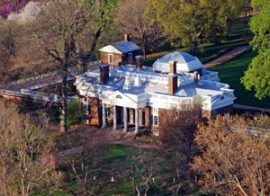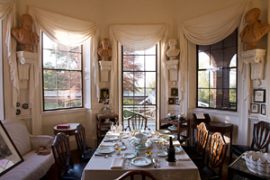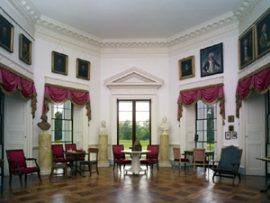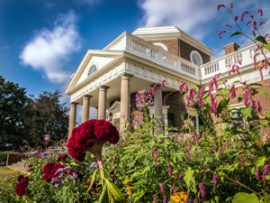Inside Monticello: Historian Susan Stein Takes the Grateful American™ Foundation Through Thomas Jefferson’s Home

Susan Stein, senior curator and vice president of museum programs at Thomas Jefferson’s home, Monticello.
Susan Stein has studied and written about one of the nation’s most intriguing Founding Fathers, Thomas Jefferson, for more than 20 years. As senior curator and vice president of museum programs at Jefferson’s beloved estate, Monticello, her main responsibility is running the curatorial department, where staff members research the objects and lives of those associated with Monticello. They also determine the physical presentation of the house; study, acquire, and care for collections; and develop exhibitions.
Stein is perhaps best known for the landmark exhibition and book, “The Worlds of Thomas Jefferson at Monticello” (1993), and her work on the four shows/film at the new Thomas Jefferson Visitor Center (2009).
Scroll down for more. And click here to watch our interview on GratefulAmericanTV.com, and here to listen to the longer version of our conversation on GratefulAmericanRadio.com.
Since curator Susan Stein joined the staff at Monticello, Thomas Jefferson’s beloved home has gained a public and historical presence. The organization has brought back the Founding Father’s original road scheme, and reinstated the kitchen road and kitchen path that survived until the early 20th century. They are also working on recreating two of the lost buildings along Monticello’s Mulberry Row, which was the principal plantation street.

An aerial view of Thomas Jefferson’s home, Monticello. Photo courtesy of Monticello.org
David Bruce Smith: The Thomas Jefferson Foundation was formed in New York City in 1923, and in the last 90-plus years you have been restoring his house and also instituting educational programs.
Susan Stein: Our mission is to engage the public in a dialogue about Jefferson’s ideas. Things have really perked up since the mid-1980s, when we focused on bringing back even more of Jefferson’s history by creating an interpretive program to engage audiences. For the first time, we started to talk about Jefferson’s larger political contributions, as well as his design of the house.
Hope Katz Gibbs: What would a typical day have been like for Thomas Jefferson?

Thomas Jefferson’s bedchamber at Monticello. Photo courtesy of Monticello.org
Susan Stein: Jefferson started his day when he could see the face of the clock at the foot of his bed in his bedchamber. That wonderful clock was designed to his specifications in Paris in 1790. Upon rising, it was his habit to plunge his feet into a basin of cold water that would have been provided to him by his enslaved butler, probably Burwell Colbert, who was with Jefferson toward the end of his life, and earlier than that a man named Jupiter.
When his family rose, Jefferson would enjoy breakfast with them in the dining room, and then he would come back to his private suite of rooms near where his bedchamber was located. One visitor dubbed this area his sanctum sanctorum because it was off-limits to everyone else. Here, he would sit at his writing table answering letters. It is said that he drudged like a workhorse at that table, writing approximately 19,000 letters in his lifetime. Later in the morning, he would ride on his horse around his farms, inspecting what was going on at his plantation — seeing what was being grown and conversing with enslaved people. He was in every way managing the plantation and engaged in thought about the plantation and its activities.
David Bruce Smith: Did Jefferson have much success as an entrepreneur?
Susan Stein: I think that he was entrepreneurial, but we wouldn’t say he was financially successful at it, not as George Washington was.
Jefferson died in debt, owing about $107,000 dollars. So he didn’t prosper financially, at least at the end of his life. In fact, he left his family with the responsibility of paying off his debt. Indeed, within six months of his death, most of his belongings — including household furnishings, farm equipment, the contents of his kitchen, and, sadly, the enslaved people he owned — were sold in January 1827 at a famous “dispersal sale.”
Hope Katz Gibbs: Let’s talk about Jefferson’s relationship with his slaves. It’s a controversial topic. What’s your perspective on it?

The formal dining room at Monticello. Photo courtesy of Monticello.org
Susan Stein: I think that slavery is the unsolved problem of the American Revolution. Jefferson devoted his life to achieving the ideals established in the Declaration of Independence: liberty, equality, and self-government. Liberty and self-government were more achievable, I think, than equality. While Jefferson expressed the noblest ideals of our nation, slavery prevailed in his time.
In 1790, for example, 20 percent of the American population was enslaved. In Virginia, that included about 293,000 people. So this was a massive, national issue.
Jefferson himself was a lifelong slaveholder. Although he understood how wrong slavery was — he called it an abomination, a blot, a deplorable entanglement — he did not free his slaves, except for five. He believed that slavery would be resolved, and should be resolved as a national issue, but that individuals could not resolve this larger problem. As we know, the Civil War was fought to resolve that issue, which extended well past Jefferson’s lifetime.
David Bruce Smith: Was Jefferson kind to his slaves?
Susan Stein: This is an important question. I think Jefferson was known to be kind to people, but I think what that question really is getting at is this: What was the nature of slavery at Monticello? Was it violent here?

Portrait of Thomas Jefferson by Rembrandt Peale, 1800; Wikipedia.com
By its very nature, slavery is a violent, coercive institution. We know that Jefferson tried to ameliorate slavery at Monticello, to make it better for individuals and their families. He did so by shifting from barracks-style housing to individual houses for enslaved people, and he tried to hire overseers who were instructed not to use the whip. He wanted enslaved people to be motivated by doing well and being rewarded for it, but that wasn’t always true here; there were particular overseers who were much more violent than Jefferson would have liked.
Hope Katz Gibbs: Speaking of controversy, tell us a little bit about Jefferson’s relationship with his slave Sally Hemings.
Susan Stein: What most historians believe now is that Jefferson had a relationship with Sally Hemings that lasted for a long time. Some people debate when the relationship began, but it certainly was going on by 1798, when a child was born to Hemings whose father is thought to have been Jefferson.

Sally Hemings, blog.mixedchicks.net
She gave birth to six children, all of whom historians now think were probably fathered by Jefferson. Two of them, Madison and Aston Hemings, were freed in Jefferson’s will, the other two surviving children — Beverly, a male, and Harriett, a female — were allowed to leave Monticello in 1822. So we think that though her children got special treatment, in fact the Hemings clan was the largest enslaved family at Monticello. In addition to Hemings matriarch Elizabeth Hemings, Sally’s mother, members of the Hemings family were enslaved here for more than five generations. Many of them occupied the most important positions and proximity to Jefferson and his family; they were very trusted members of the community.
Hope Katz Gibbs: Is it true that Elizabeth had a relationship with John Wales — the father of Jefferson’s wife, Martha?
Susan Stein: Yes, we think that Wales had a relationship with Elizabeth Hemings. In fact, she herself was the daughter of an African woman and an English sea captain. It is also believed that Elizabeth helped care for Martha Jefferson in her final illness before she died in 1782, just 10 years after she and Jefferson were married in 1772.
Hope Katz Gibbs: Historians know so much about Jefferson that the general public doesn’t. Can you share some of the things that you, as a Jefferson expert, want more people to know about?

The entrance of Monticello, which is filled with artifacts from Thomas Jefferson’s travels, plus a clock he built. Photo courtesy of Monticello.org
Susan Stein: I think many people probably don’t realize that he was as artistically creative as he was politically creative. In addition to articulating our national ideals, he gave shape to America’s public architecture, and he was committed to seeing self-government succeed.
He wanted to see Americans respected in the eyes of the rest of the world, and having an ennobling architecture was one way he thought that America could engender that respect. So he designed the Virginia State Capitol, that wonderful Neoclassical building modeled after the Maison Carrée in the south of France, which was widely copied in America. Architect Benjamin Henry Latrobe, one of the architects of the U.S. Capitol in Washington, wrote that Jefferson planted the arts in America. I think that that’s something most people don’t realize.
David Bruce Smith: You talked earlier about Jefferson’s sanctum sanctorum, where he wrote letter after letter after letter. How do you think he would feel about Facebook?

Photo courtesy of Monticello.org
Susan Stein: I think in some ways he would probably like the idea that he could communicate with people so easily and effectively. Of course, my colleague Jeff Looney, the editor of “The Jefferson Papers,” would likely tell you that a lot of Jefferson’s correspondence was meant to be private, so how transparent any of the Founding Fathers wanted to be is a very interesting question. I think they would want to take advantage of a network to communicate their ideas for probably a good deal of their correspondence, but they probably would want their behind-the-scenes political operations to remain private.
David Bruce Smith: Jefferson didn’t burn his letters, as did Martha Washington. Is that because he wanted his correspondences to be his legacy?
Susan Stein: Yes. In fact here’s an interesting bit of historical trivia. Jefferson made copies of his letters on the two different kinds of copying presses that he owned. One of them was made by James Watt, who created the first steam engine. The other was made by Isaac Hawkins, an inventor who practiced civil engineering and co-invented the ever-pointed pencil and the upright piano. His copying press was more of a double-acting pen.
Indeed, the reason we know so much about Jefferson today is that so many of his letters survived, and since 1950, have been studied by scholars. At Monticello, they are being edited and annotated by teams of historians who are making these letters accessible to the public. It is very exciting.

The blooming gardens at Monticello. Photo courtesy of Monticello.org
In fact, in recent years at the Thomas Jefferson Foundation, we have been putting many more resources into making these letters accessible. For example, we took on editing and publishing The Papers of Thomas Jefferson: Retirement Series so that we could edit both projects.
The main project is headquartered at Princeton University and the Retirement Series here. With both organizations working on the projects, everyone throughout the world will have access to all of these letters earlier. Many of these letters are accessible online now through the National Archives.
Improving access to this material is one reason that Jefferson would probably be in favor of Facebook. He would be pleased to see how it can help us engage students and teachers, and provide exciting materials in the classroom and beyond.
David Bruce Smith: Jefferson died on July 4, 1826, the same day as John Adams. How did having two former presidents die at the same time affect the way in which their loss was grieved by the country?
Susan Stein: It was a phenomenon that they both died on the same day, exactly 50 years after the Declaration of Independence was presented and approved by Congress. The public saw their same-day deaths as being cataclysmic, and that sentiment filled the press. In fact, when Adams died, he believed that Jefferson was still alive — but Jefferson actually predeceased Adams. Jefferson had been sick for days, in and out of consciousness, and it was his grandson-in-law, Nicholas Trist, who told Jefferson that it was the fourth of July. Everyone understood this to be a dramatic moment; I think that if a playwright had been trying to conceive of an end to Jefferson’s life, it could not have been eclipsed by what actually happened.




